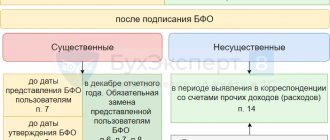Provisions for doubtful debts: accounting and tax accounting
Provisions for doubtful debts are formed in both accounting and tax accounting. However, the economic essence of these reserves, as well as the procedure for their formation in accounting and tax accounting, are completely different.
Tax accounting
In tax accounting, reserves for doubtful debts serve as reserves for future expenses. The purpose of forming these reserves is to reduce the tax burden of an organization that has calculated income tax using the accrual method on goods (works, services) sold and paid it to the budget, but has not received payment from customers. In fact, the organization diverted its own funds to pay the tax.
When the buyer's (customer's) debt becomes uncollectible, it is included directly in non-operating expenses for income tax purposes. If the organization has previously created a reserve for this debt, then the bad debt is written off against the reserve.
The procedure for forming reserves for doubtful debts for profit tax purposes is regulated by Art. 266 Tax Code of the Russian Federation.
Doubtful debt is any debt that:
- arose in connection with the sale of goods, performance of work, provision of services;
— (and) not repaid within the time limits established by the agreement;
— (and) is not secured by a pledge, surety, or bank guarantee.
Bad debt (debt that cannot be collected):
— debt for which the statute of limitations has expired (3 years according to Article 196 of the Civil Code of the Russian Federation);
- (or) a debt for which, in accordance with civil law, the obligation has been terminated:
a) due to the impossibility of its execution;
b) on the basis of an act of a state body;
c) due to the liquidation of the organization.
Extract from the Civil Code of the Russian Federation
Article 416. Termination of an obligation due to impossibility of fulfillment
1. An obligation is terminated by impossibility of performance if it is caused by a circumstance for which neither party is responsible.
2. If it is impossible for the debtor to fulfill an obligation caused by the guilty actions of the creditor, the latter has no right to demand the return of what he has fulfilled under the obligation.
Article 417. Termination of an obligation based on an act of a state body
1. If, as a result of the issuance of an act of a state body, the fulfillment of an obligation becomes impossible in whole or in part, the obligation is terminated in full or in the relevant part. The parties who suffered losses as a result of this have the right to demand compensation in accordance with Articles 13 and 16 of this Code.
Article 419. Termination of an obligation by liquidation of a legal entity
An obligation is terminated by the liquidation of a legal entity (debtor or creditor), except in cases where the law or other legal acts assign the fulfillment of the obligation of a liquidated legal entity to another person (for claims for compensation for harm caused to life or health, etc.).
The reserve is created at the end of each reporting and tax period based on the inventory:
- for debt over 90 days - the entire amount of debt is included in the reserve;
- for debts from 45 to 90 days - 50% of the debt amount is included in the reserve;
- for debts up to 45 days - no reserve is created.
The total amount of the reserve in the reporting (tax) period cannot exceed 10% of the sales income for the specified period, which is determined in accordance with Art. 249 of the Tax Code of the Russian Federation.
The accrued amount of the reserve (but not more than the maximum amount) is included in non-operating expenses as of the last date of the reporting (tax) period (clause 7, clause 1, article 265, clause 3, article 266 of the Tax Code of the Russian Federation).
In the following cases, the amount of the formed reserve is included in non-operating income:
- when the debtor repays the debt;
— if the maximum reserve amount is exceeded at the end of the reporting period (10% of income);
— unused reserve amount.
The tax accounting policy should define (clause 5 of Article 266):
— the amount of the reserve unused in the reporting period is transferred to the next reporting (tax) period;
— (or) the amount of the reserve unused at the end of the reporting (tax) period is restored (included in non-operating income).
In addition, the tax accounting policy should approve the forms of tax registers for the formation and use of reserves for doubtful debts. An approximate example of a register for the formation of a reserve is shown in Table 1.
Table 1
| Name of organization:_______________ INN _____________________ Register of formation of reserves for doubtful debts as of _______ Inventory protocol No. ____ dated _______ | |||||
| Debtor's name | The document on the basis of which the receivables arose (date, number) | Sum | including by the number of days of delay from the period established by the contract: | ||
| up to 45 days | from 45 to 90 days | over 90 days | |||
| 1 | 2 | 3 | 4 | 5 | 6 |
| Total accounts receivable | |||||
| including subject to inclusion in the reserve | sum of columns 5 and 6 for this line | X | 50% of the total amount in column 5 | 100% of the total amount in column 6 | |
| Reserve limit | 10% of revenue for the reporting (tax period) | X | X | X | |
| Amount of reserve to be included in non-operating expenses | determined by comparing the amount of the calculated reserve and the limit value | X | X | X | |
Accounting
In accounting, provisions for doubtful debts are valuation reserves. These reserves are formed at the end of the reporting period in order to bring the value of assets presented in the balance sheet to their current (real) value. The receivables reflected in the financial statements are reduced by the amount of the formed reserves.
The procedure for the formation of reserves is regulated by clause 70 of the regulations on accounting and financial reporting in the Russian Federation (Order of the Ministry of Finance dated July 29, 1998 No. 34n).
Any receivables of an organization that are not repaid or with a high degree of probability will not be repaid within the time limits established by the agreement and are not secured by appropriate guarantees are considered doubtful.
The organization creates reserves for doubtful debts in the event that accounts receivable are recognized as doubtful, with the amounts of reserves being allocated to the financial results of the organization. The amount of the reserve is determined separately for each doubtful debt, depending on the financial condition (solvency) of the debtor and the assessment of the likelihood of repaying the debt in whole or in part.
If by the end of the reporting year following the year in which the reserve for doubtful debts was created, this reserve is not used in any part, then the unspent amounts are added to the financial results when drawing up the balance sheet at the end of the reporting year.
The amount of the created reserve is reflected in the credit of balance sheet account 63 in correspondence with subaccount 91.2 “Other expenses”.
Example
According to the accounting policy of the organization, the reserve for doubtful debts is created based on the results of the annual inventory on the basis of the protocol of the inventory commission, approved by the head of the organization. In the protocol, the commission members decide to recognize the overdue debt as doubtful.
At the end of 2010, accounting provisions were made for the debt of “Company A” in the amount of RUB 1,700,000. and “Company B” in the amount of 300,000 rubles.
During 2011, Firm A partially repaid its debt. The reserve for “Company A” was restored for the indicated amounts.
The movement of the reserve for doubtful debts is reflected in a special accounting register (see table 2). Table 3 shows an extract from the Book of Business Operations on the accrual of the reserve at the end of 2010 and the movement of the reserve in 2011.
At the end of 2011, the amount of unused reserve for “Company A” was 200,000 rubles. was restored. The statute of limitations for the debt of “Company B” expired; this debt was written off from the reserve. Based on the results of the annual inventory, on the basis of the protocol of the inventory commission, reserves for doubtful debts were formed in the accounting records as of December 31, 2011. Postings for the restoration and creation of reserves are documented in an accounting certificate (see Table 4).
table 2
| Accounting for the provision for doubtful debts 2011 | ||||||
| Counterparty | Agreement | Reserve as of 12/31/2010 | Reserve restoration | Remaining reserve | ||
| date | Document | Sum | ||||
| Company A | No. 18 from 05.15.2010 | 1 700 000 | 10.04.11 | p.p. 181 | 700 000 | 1 000 000 |
| 30.07.11 | p.p. 200 | 600 000 | 400 000 | |||
| 18.09.11 | p.p. 231 | 200 000 | 200 000 | |||
| Company B | No. 5 from 09/28/2007 | 300 000 | — | — | — | 300 000 |
Table 3
| Extract from the Book of Business Operations | ||||
| date | the name of the operation | Debit | Credit | Sum |
| 31.12.2010 | A reserve for doubtful debts has been formed for “Company A” | 91.2 | 63 | 1 700 000 |
| 31.12.2010 | A reserve for doubtful debts has been formed for “Company B” | 91.2 | 63 | 300 000 |
| 10.04.2011 | Partially repaid the debt by “Company A” | 51 | 62 | 700 000 |
| The reserve for “Company A” was restored for the amount of repaid debt | 63 | 91.1 | 700 000 | |
| 30.07.2011 | Partially repaid the debt by “Company A” | 51 | 62 | 600 000 |
| The reserve for “Company A” was restored for the amount of repaid debt | 63 | 91.1 | 600 000 | |
| 18.09.2011 | Partially repaid the debt by “Company A” | 51 | 62 | 200 000 |
| The reserve for “Company A” was restored for the amount of repaid debt | 63 | 91.1 | 200 000 | |
Table 4
| LLC "Our Firm" | |||||||
| Accounting certificate No. 65 dated December 31, 2011 | |||||||
| Contents of the operation: accrual of the reserve for doubtful debts according to the annual inventory data | |||||||
| (in rubles) | |||||||
| No. | Debit | Credit | Sum | Posting Contents | Base | ||
| Check | Analytical account | Check | Analytical account | ||||
| 1 | 63 | Company A | 91.1 | provision for doubtful debts | 200 000 | restoring the reserve balance | Minutes of the inventory commission No. 57 dated 02.20.12 |
| 2 | 63 | Company B | 62 | Company B | 300 000 | write-off against bad debt reserve | |
| 3 | 91.2 | provision for doubtful debts | 63 | Company A | 200 000 | reserve for | |
| 4 | 91.2 | provision for doubtful debts | 63 | Company B | 860 000 | reserve for | |
| Compiled by: accountant Ivanova /Ivanova M.I./ | |||||||
| Checked by: Chief Accountant Petrova /Petrova O.A./ | |||||||
Accounting policy for NU in relation to the reserve
- recognizing the debt as doubtful;
- assessing the likelihood of receiving a debt;
- determining the size of the reserve being formed.
It is not necessary to include in the accounting policies a provision on the creation or non-creation of such a reserve. It is necessary to create it if there is a debt recognized as doubtful. In addition, the inclusion in the accounting policy of a decision not to create a reserve for doubtful debts may lead to the recognition of accounting data as not meeting the reliability criterion.
In the tax accounting policy, it is enough to indicate the fact of creation or non-creation of a reserve and the frequency with which the results of the debt inventory will be taken into account. Other additional points related to the reserve may not be prescribed, since in relation to them you will have to be guided by the provisions of Art. 266 Tax Code of the Russian Federation.
Results
The answer to the question about the mandatory provision for doubtful debts is positive in relation to the reserve created in accounting. The creation of a similar reserve in tax accounting is voluntary, but in terms of the formation procedure and size it is significantly more regulated than for accounting.
The formation of a reserve for doubtful debts for the purposes of tax accounting is not necessary. If it is created, then when working with a reserve it is necessary to comply with all the rules established for it by Art. 266 Tax Code of the Russian Federation. Differences in the procedures for creating a reserve in accounting and accounting records determine the presence of discrepancies between the two accounting data, regarded as temporary differences. These differences are taken into account according to the rules of PBU 18/02.
We suggest you read: How to return money withdrawn by bailiffs and where to go
Limitations when carrying forward losses
Profit for the reporting (tax) periods 2017-2020 can be reduced by the amount of losses of previous tax periods by no more than 50%.
This follows from paragraph 2.1 of Article 283 of the Tax Code of the Russian Federation, which has been in force since 01/01/2017 (clause “c”, paragraph 25 of Article 2, paragraph 5 of Article 13 of Law No. 401-FZ).
Consequently, the tax base for 2021 can be reduced by losses from previous years down to zero. However, this only applies to losses from 2006 to 2015 (the previous ten tax periods). It is impossible to reduce taxable profit for 2021 by earlier losses (clause 2 of Article 283 of the Tax Code of the Russian Federation).
Moreover, as of January 1, 2017, paragraph 2 of Article 283 of the Tax Code of the Russian Federation does not mention a ten-year period for carrying forward losses. Losses received in 2007 and later can be carried forward to an unlimited number of subsequent tax periods, and not for 10 years, as before (clause “b”, clause 25, article 2, clause 16, article 13 of Law No. 401-FZ ), but their total size in 2017-2020 should not exceed 50% of the profit of the current period.







